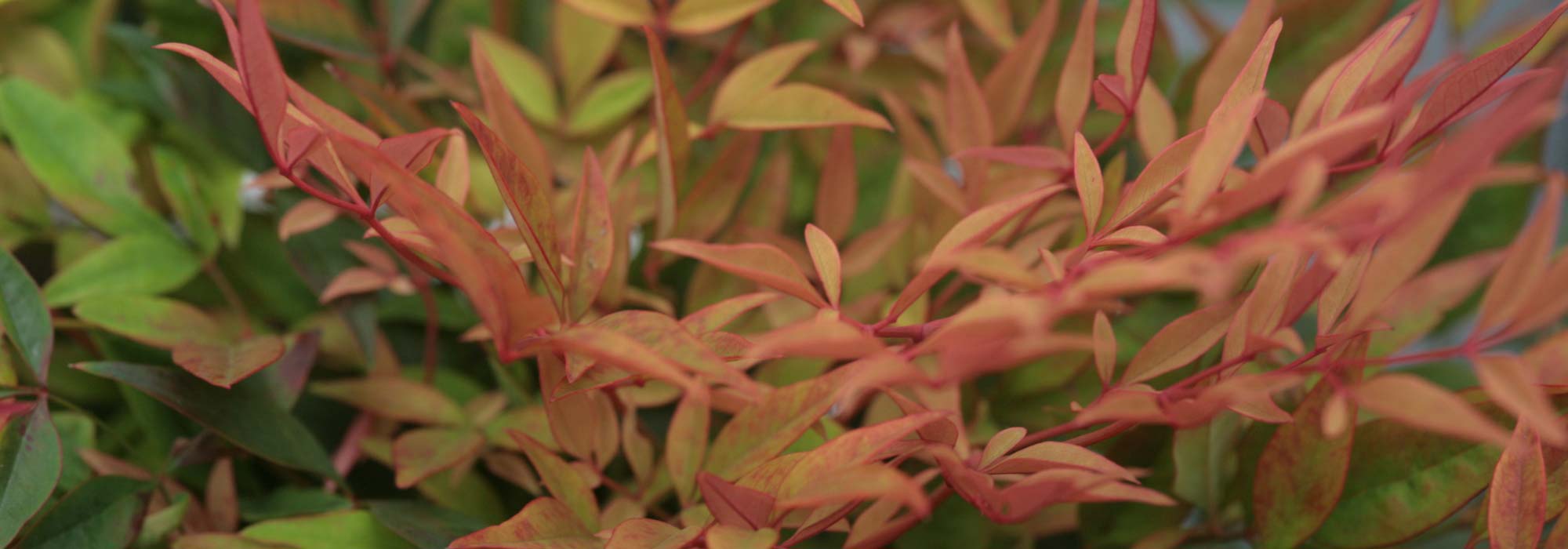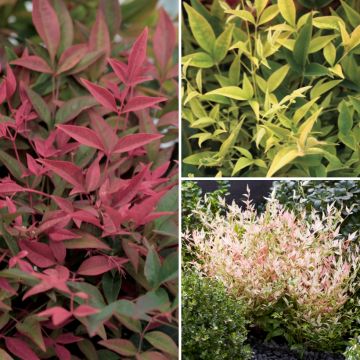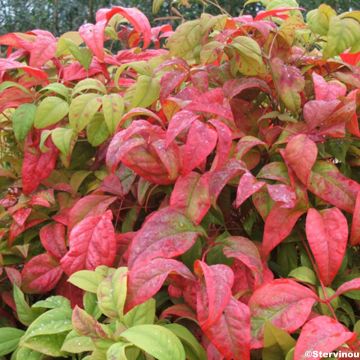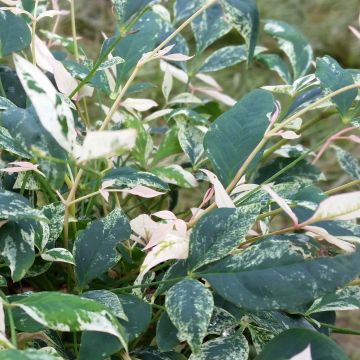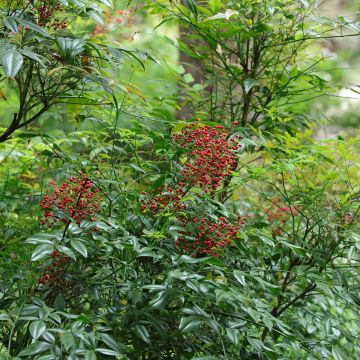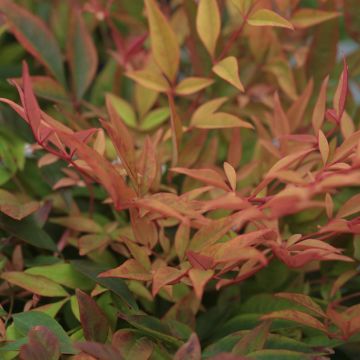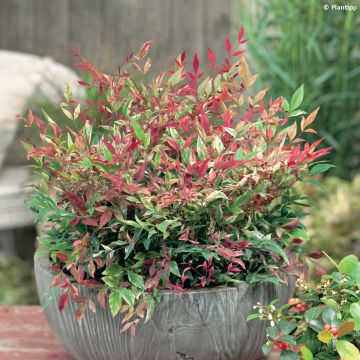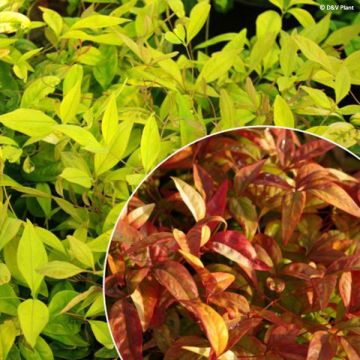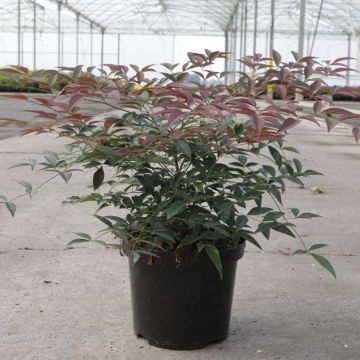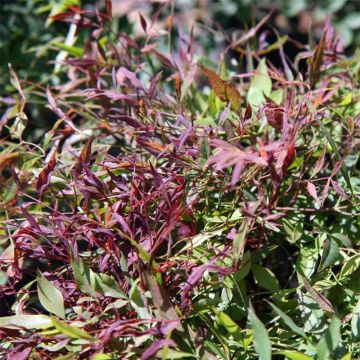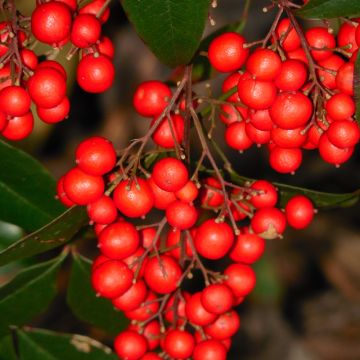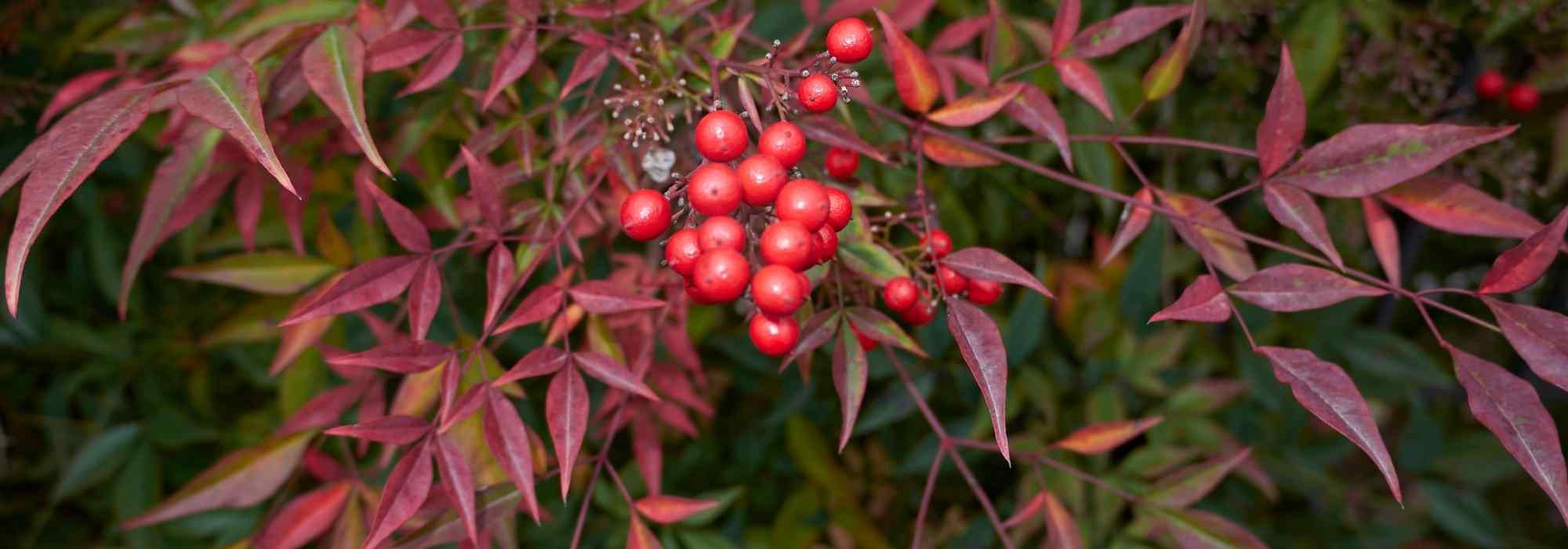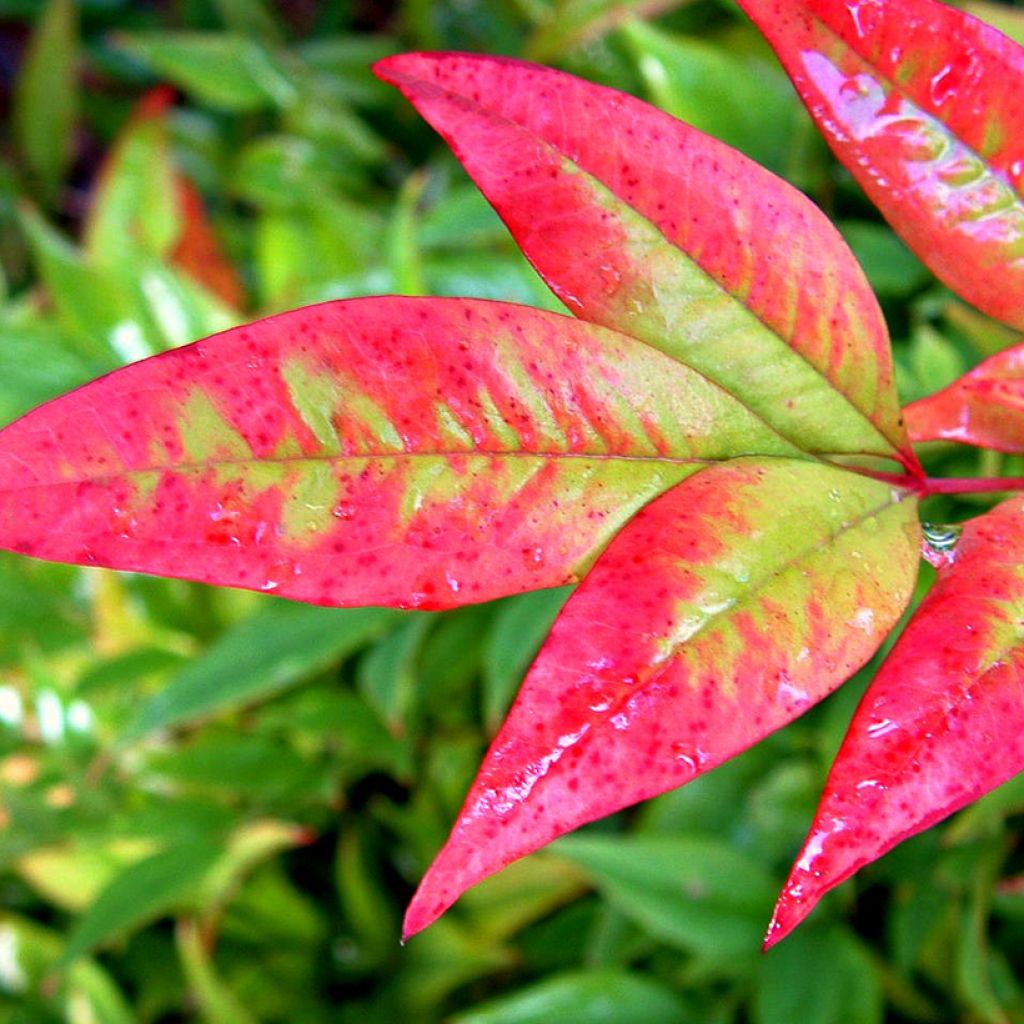

Nandina domestica Moon Bay - Sacred Bamboo
Nandina domestica Moon Bay - Sacred Bamboo
Nandina domestica Moon Bay® PBR
Sacred Bamboo, Heavenly Bamboo
Special offer!
Receive a €20 voucher for any order over €90 (excluding delivery costs, credit notes, and plastic-free options)!
1- Add your favorite plants to your cart.
2- Once you have reached €90, confirm your order (you can even choose the delivery date!).
3- As soon as your order is shipped, you will receive an email containing your voucher code, valid for 3 months (90 days).
Your voucher is unique and can only be used once, for any order with a minimum value of €20, excluding delivery costs.
Can be combined with other current offers, non-divisible and non-refundable.
Home or relay delivery (depending on size and destination)
Schedule delivery date,
and select date in basket
This plant carries a 24 months recovery warranty
More information
We guarantee the quality of our plants for a full growing cycle, and will replace at our expense any plant that fails to recover under normal climatic and planting conditions.

Does this plant fit my garden?
Set up your Plantfit profile →
Description
The Nandina domestica Moon Bay is a variety of Sacred Bamboo that will seduce with its compact, dense and well-proportioned habit, and its fabulous autumn and winter colours that bring life to the garden during a period of the year short of flowers. Its leaves range from yellow to light green and turn red, lemon yellow, and orange at the end of the season. This bush also offers white flowers in panicles at the beginning of summer, sometimes followed by fruits. As decorative as it is easy to grow, and attractive all year round, the sacred bamboo is wonderful in flower beds and large borders or even a pretty pot on the terrace.
The 'Moon Bay' Sacred Bamboo belongs to the berberidaceae family. This bush is a horticultural selection derived from the Nandina domestica native to India, China, and Japan. Its growth is quite slow and its adult size will reach approximately 80-90cm (31.5-35.4in) in all directions. This plant forms erect stems from its rhizomatous stump, but they are not branched. They resemble those of bamboo and are adorned with leaves divided into long, narrow, and pointed leaflets. Its vegetation is dense, compact, and nicely rounded. The plant is beautiful all year round, and particularly colourful when it is cold. Its young reddish-purple shoots then produce leaves that are slightly yellowish green, becoming greener in summer, before colouring in flamboyant tones. In June-July, large conical panicles of cream-white flowers appear that are 20-30cm (7.9-11.8in) long. If the summer is long and warm enough, they are followed by clusters of pretty bright red fruits. It is best to plant another sacred bamboo nearby to obtain fruits, as the plant is not self-fertile. The fruits persist on the branches for a long time in winter.
Nandina domestica Moon Bay is particularly attractive in large groups It can be associated, for example, with a Mexican orange tree, Japanese 'Little Princess' spireas, 'Fire Glow' euphorbias, Isalia ground cover roses, or daylilies. Also consider pairing it with blue or purple-flowered asters, the contrast of colours will be magnificent at the end of the season. This small bush will also be beautiful in a large pot on the terrace, in a non-scorching exposure and with regular watering. In a large border, it can be accompanied by Lespedeza thunbergii and dwarf abelias.
Nandina domestica Moon Bay - Sacred Bamboo in pictures
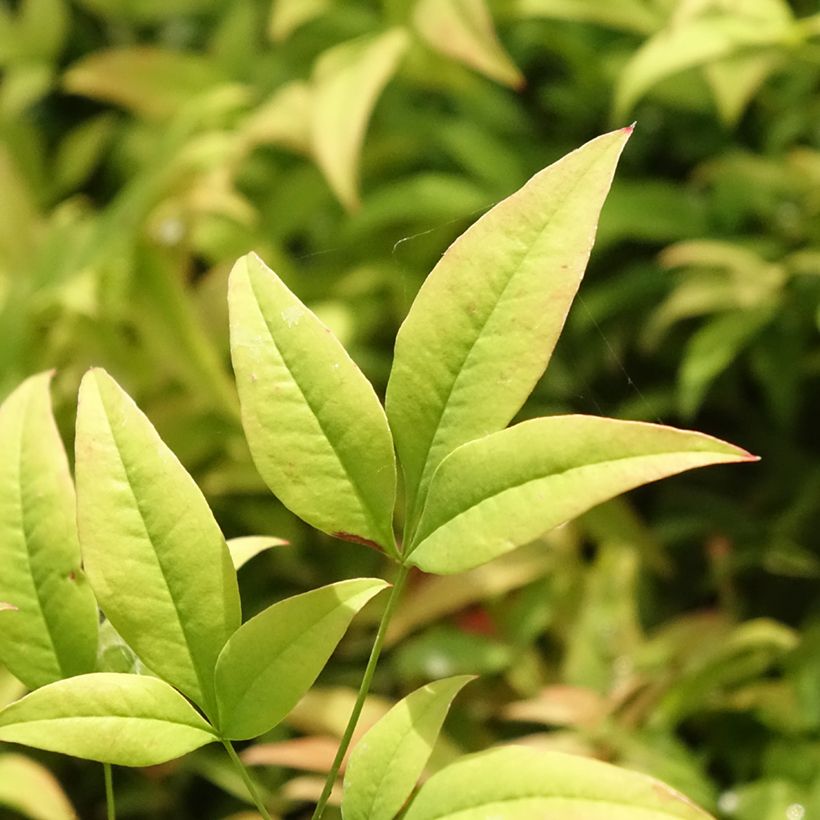

Plant habit
Flowering
Foliage
Botanical data
Nandina
domestica
Moon Bay® PBR
Berberidaceae
Sacred Bamboo, Heavenly Bamboo
Cultivar or hybrid
Other Nandina
View all →Planting and care
Plant Moon Bay Sacred Bamboo in soft, deep, well-drained, even slightly chalky, moist to occasionally dry, soil. Once well established, this plant can tolerate summer drought if the soil is deep. It prefers sunny but not scorching situations, or partial shade, but can also grow under sparsely wooded cover. The colours will be brighter if the plant is exposed to the sun. Avoid drying winds and reserve a location sheltered from severe cold. This bush is hardy down to -15 °C (5°F) under optimal conditions, protect its base with a thick mulch of dead leaves in the coldest regions. If the aboveground part freezes, prune the plant at ground level in February-March. Pruning is limited to removing dead wood and excess or weak shoots in winter.
Planting period
Intended location
Care
Planting & care advice
This item has not been reviewed yet - be the first to leave a review about it.
Haven't found what you were looking for?
Hardiness is the lowest winter temperature a plant can endure without suffering serious damage or even dying. However, hardiness is affected by location (a sheltered area, such as a patio), protection (winter cover) and soil type (hardiness is improved by well-drained soil).

Photo Sharing Terms & Conditions
In order to encourage gardeners to interact and share their experiences, Promesse de fleurs offers various media enabling content to be uploaded onto its Site - in particular via the ‘Photo sharing’ module.
The User agrees to refrain from:
- Posting any content that is illegal, prejudicial, insulting, racist, inciteful to hatred, revisionist, contrary to public decency, that infringes on privacy or on the privacy rights of third parties, in particular the publicity rights of persons and goods, intellectual property rights, or the right to privacy.
- Submitting content on behalf of a third party;
- Impersonate the identity of a third party and/or publish any personal information about a third party;
In general, the User undertakes to refrain from any unethical behaviour.
All Content (in particular text, comments, files, images, photos, videos, creative works, etc.), which may be subject to property or intellectual property rights, image or other private rights, shall remain the property of the User, subject to the limited rights granted by the terms of the licence granted by Promesse de fleurs as stated below. Users are at liberty to publish or not to publish such Content on the Site, notably via the ‘Photo Sharing’ facility, and accept that this Content shall be made public and freely accessible, notably on the Internet.
Users further acknowledge, undertake to have ,and guarantee that they hold all necessary rights and permissions to publish such material on the Site, in particular with regard to the legislation in force pertaining to any privacy, property, intellectual property, image, or contractual rights, or rights of any other nature. By publishing such Content on the Site, Users acknowledge accepting full liability as publishers of the Content within the meaning of the law, and grant Promesse de fleurs, free of charge, an inclusive, worldwide licence for the said Content for the entire duration of its publication, including all reproduction, representation, up/downloading, displaying, performing, transmission, and storage rights.
Users also grant permission for their name to be linked to the Content and accept that this link may not always be made available.
By engaging in posting material, Users consent to their Content becoming automatically accessible on the Internet, in particular on other sites and/or blogs and/or web pages of the Promesse de fleurs site, including in particular social pages and the Promesse de fleurs catalogue.
Users may secure the removal of entrusted content free of charge by issuing a simple request via our contact form.
The flowering period indicated on our website applies to countries and regions located in USDA zone 8 (France, the United Kingdom, Ireland, the Netherlands, etc.)
It will vary according to where you live:
- In zones 9 to 10 (Italy, Spain, Greece, etc.), flowering will occur about 2 to 4 weeks earlier.
- In zones 6 to 7 (Germany, Poland, Slovenia, and lower mountainous regions), flowering will be delayed by 2 to 3 weeks.
- In zone 5 (Central Europe, Scandinavia), blooming will be delayed by 3 to 5 weeks.
In temperate climates, pruning of spring-flowering shrubs (forsythia, spireas, etc.) should be done just after flowering.
Pruning of summer-flowering shrubs (Indian Lilac, Perovskia, etc.) can be done in winter or spring.
In cold regions as well as with frost-sensitive plants, avoid pruning too early when severe frosts may still occur.
The planting period indicated on our website applies to countries and regions located in USDA zone 8 (France, United Kingdom, Ireland, Netherlands).
It will vary according to where you live:
- In Mediterranean zones (Marseille, Madrid, Milan, etc.), autumn and winter are the best planting periods.
- In continental zones (Strasbourg, Munich, Vienna, etc.), delay planting by 2 to 3 weeks in spring and bring it forward by 2 to 4 weeks in autumn.
- In mountainous regions (the Alps, Pyrenees, Carpathians, etc.), it is best to plant in late spring (May-June) or late summer (August-September).
The harvesting period indicated on our website applies to countries and regions in USDA zone 8 (France, England, Ireland, the Netherlands).
In colder areas (Scandinavia, Poland, Austria...) fruit and vegetable harvests are likely to be delayed by 3-4 weeks.
In warmer areas (Italy, Spain, Greece, etc.), harvesting will probably take place earlier, depending on weather conditions.
The sowing periods indicated on our website apply to countries and regions within USDA Zone 8 (France, UK, Ireland, Netherlands).
In colder areas (Scandinavia, Poland, Austria...), delay any outdoor sowing by 3-4 weeks, or sow under glass.
In warmer climes (Italy, Spain, Greece, etc.), bring outdoor sowing forward by a few weeks.






























